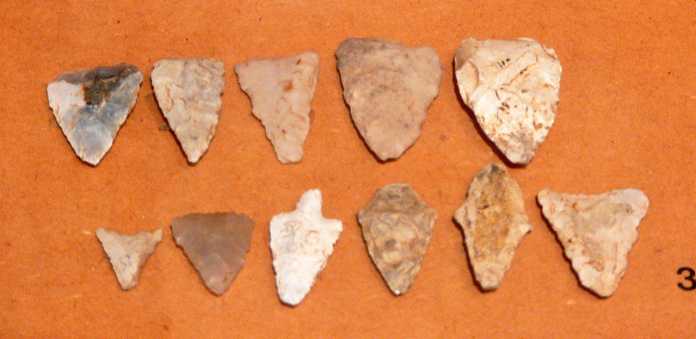Archaeologists have published a new paper in New Scientist that confirms what previous research has shown: numerous periods during recent history have been as warm as or warmer than the present.
The paper, “Climate change has revealed a huge haul of ancient arrows in Norway,” discusses the findings of researchers from the Universities of Cambridge, Oslo, and Bergen. The researchers discovered a “treasure trove” of arrows, arrowheads, clothing, and other artifacts, recently uncovered by a receding ice in a mountainous region of southern Norway. The oldest arrows and artifacts date from around 4100 BC. The youngest artifacts date from approximately AD 1300, at the end of the Medieval Warm Period. Because present temperatures are only now exposing some of the artifacts were deposited when no ice covered the ground, temperatures were clearly warmer during the many periods when artifacts were deposited.
Along with the arrows and other artifacts, the researchers found nearly 300 specimens of reindeer antler and bone exposed by receding ice. Because reindeer presently frequent the area, the archaeologists say they are confident the area has served as an important hunting ground, off and on, for millennia.
The fact that artifacts were found from several different periods separated by hundreds and thousands of years in time indicates the ice and snow in the region has expanded and receded several times over the current interglacial period.
Elsewhere in Norway, scientists also recently uncovered what they have labeled a “Viking highway,” a route the ancient peoples inhabiting the region used to travel regularly. The route had for approximately 2,000 years been covered by snow and ice that expanded as the region’s climate shifted from a relatively warm period, comparable to present temperatures, to a colder period during which “permanent” thick snow and ice cover formed. This erected the equivalent of a “highway closed” sign.
More evidence for relative warm periods in recent history has recently been found half a world away in frozen Antarctica, where scientists report they have discovered perfectly preserved, 800-year-old penguin remains exposed by a patch of melting ice along the Antarctic coast.
In an article published in the peer-reviewed journal Geology, scientists reported discovering what appeared to be the fresh remains of Adelie penguins in a region currently uninhabitable by penguins. Carbon dating showed the penguin remains were approximately 800 years old, implying the remains had only recently been exposed by thawing ice. Further analysis of the site showed penguins colonized and abandoned the site multiple times between 800 and 5,000 years ago.
Penguins are currently unable to inhabit the area where the frozen corpse was found because “fast ice” (ice that extends from the Antarctic shore many miles out into the ocean) prevents them from accessing the ocean for food. During the Medieval Warm Period, the absence of fast ice allowed penguins to colonize and nest in the area for hundreds of years.
Numerous other frozen and near-perfectly preserved human and animal corpses have been discovered in Arctic and glacial alpine regions in recent decades as the Earth has modestly warmed.
The most famous of these, perhaps, is the frozen human mummy scientists call Otzi, which hikers discovered in 1991 in a then-recently thawed area of the northern Italian Alps. Analysis of the mummy’s clothing, body, stomach contents, and the plants found frozen around it indicate Otzi died, was nearly flash-frozen in place, and then covered over by and ice- and snow-driven glacial expansion more than 5,300 years ago. This fact suggests the Earth was just as warm, and the snow and ice extent just as low, 5,300 years ago as it is today.
Also, in the December 3, 2019 edition of Geophysical Research Letters, scientists examining materials from three lakes on the Svalbard archipelago jutting into the Arctic Ocean found evidence that from 11,700 through 8,200 years BP, temperatures in the region often exceeded both currently recorded temperatures and those projected by the Intergovernmental Panel on Climate Change to occur even under its worst-case scenarios. Such ancient warmth existed for hundreds of years at a time.
According to Svalbard evidence, peak warmth occurred approximately 10,000 years before the present, at which time temperatures in the region were estimated to be 7 degrees Celsius warmer than today.
Proxy data from tree rings, shell middens, and pollen trapped in peat, fossilized remains, and oral and written historical records all show not only that global temperatures have been as warm as or warmer than today, but also that all of these warm periods have been a boon for life, including the expansion of human communities. Indeed, history shows these warmer periods contributed to the rise of agricultural societies, human civilizations with large permanent settlements (which have recently morphed into megalopolises), and modern nation-states.
[Photo courtesy of Wikimedia commons, https://commons.wikimedia.org/wiki/File:Neolithic_arrowheads_Chariez.jpg]




















[…] https://climaterealism.com/2020/12/new-archaeological-finds-shows-earth-is-typically-warmer-than-tod… […]
Besides this gem article I have read of archeological evidence during the Medieval era and Roman era that show sea levels where higher then today. The glaciers of the alps have retreated several times in the Holocene era.